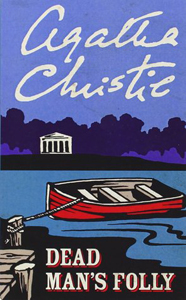“Dead Man’s Folly” (1956) is a page-turner with an evocative main setting of a carnival on a country mansion’s grounds, humorous interplay between Ariadne Oliver and Hercule Poirot, and engrossing exchanges of theories among investigators.
Carnival atmosphere
Like many other Agatha Christie novels of this period, she falls back on old tropes for the solution. Granted, I didn’t guess whodunit (I almost never do). But let’s just say that in “Dead Man’s Folly” the journey is more appealing than the destination.
Before that, the author builds up a wonderful atmosphere. Nasse House hosts a Fete – a home-grown yard event with games and a fortune teller for which they charge admission. Although English law was tight enough by the Fifties that it’s technically illegal, Inspector Bland drolly notes that it’s not something law enforcement takes seriously.

“Dead Man’s Folly” (1956)
Author: Agatha Christie
Genre: Mystery
Series: Hercule Poirot No. 35, Ariadne Oliver No. 4
Setting: Devon, England; 1956
He’s more concerned with the murder. In “Dead Man’s Folly” we have an early example of what is essentially murder-mystery theater. Mystery novelist Mrs. Oliver (famously a stand-in for Christie) is engaged to create a murder mystery for the Fete. She calls upon Poirot to present the prizes, but that’s an excuse to get him there – she has a woman’s intuition that a real murder will happen.
In addition to the raucous atmosphere, “DMF” is different from the norm in that Poirot takes months to solve this one. After the events at the manor wrap with the crime unsolved, Poirot returns to London with the case still nagging at him.
Party killer
“DMF” is an early – and superior – version of “Hallowe’en Party,” another one where Oliver calls on Poirot and a happy party turns sour. Christie shows interest in younger generations, having lots to say about teenage victim Marlene and her simplistic desires.
The author’s humorous default suspect of “a tramp” has become “a sex maniac.” I think she uses this winkingly – for the most part. Next door to Nasse House another mansion has been turned into a youth hostel that’s overflowing with teens. The story’s non-professional sleuths suspect the “sex maniac killer” comes from among these “foreigners.” The Belgian Poirot can, of course, sympathize.
Tapping into an older issue of English law, Christie presents a criticism of (or at least a sympathetic personalization of) death taxes via Mrs. Folliat, who has lost her husband and two sons. She has to sell Nasse House; now she rents a cottage on the grounds from new owner Sir George Stubbs.
Christie also taps into “the war” and politics, but in notably brushed-aside fashion this time, as if she’s sparing us from repetition on these particular topics. Her statement on Communism seems to be that young Communists wear odd shirts with turtles on them (if I’m interpreting that right).

Nonetheless, “DMF” is a thoughtful novel until the revelation, and here I must institute a SPOILER WARNING in order to discuss it further.
But is it believable? (Spoilers)
After the murder of Marlene kicks things off, Hattie Stubbs, George’s simple-minded but beautiful wife, goes missing. The solution is this: Sir George killed the actual Hattie and buried her under the titular folly (a little structure for sitting and looking at nature) before the book’s events.
George’s true lover has since taken over Hattie’s identity, and at the party she sneaks out by posing as one of the youth hostel guests next door. After enough time has passed and Hattie is declared dead, George and this woman (who would now use her true identity, or a new one) would meet, as if for the first time.
A reader is asked to believe that this false Hattie has fooled everyone she needs to fool for quite some time simply by wearing large hats and elaborate dresses. It’s a common Christie trick and the one I find hardest to believe, especially when it goes beyond small doses. The author stretches matters further here, as Hattie is an exotic Caribbean native and the false Hattie is Italian.
Christie asks us to buy an extraordinary lack of basic observational skills from the characters. Yes, many are humorously self-centered in that typical Christie way. And the observant ones like Oliver and Poirot don’t have a basis for comparison: They only meet one “Hattie.”
Doubling down, the author also uses the trope wherein someone presumed to be dead is instead alive and has assumed a new identity. It’s amazing how easy it was to do this back in the day. At least in Agatha Christie novels.
Every week, Sleuthing Sunday reviews an Agatha Christie book or adaptation. Click here to visit our Agatha Christie Zone.

